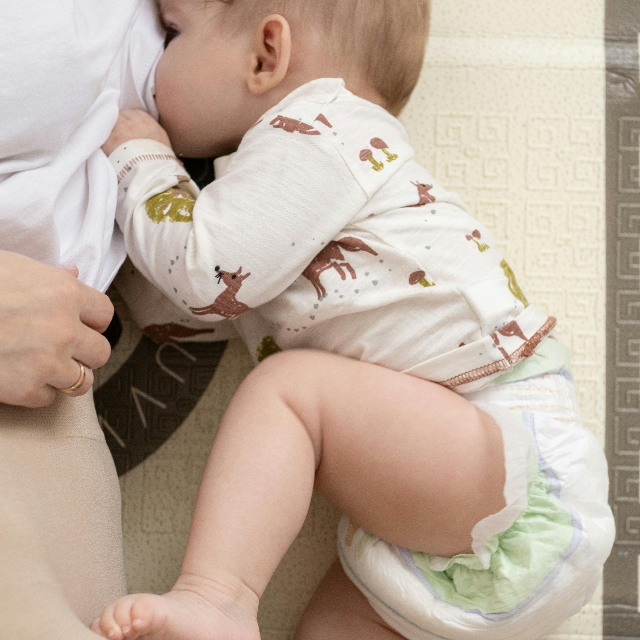
Diaper blow-outs: the phrase that can send shivers down any parent’s spine! If you’ve ever experienced the chaos of a surprise explosion that seems to defy all logic, you’re not alone. But fear not! In this article, we’ll dive into the world of diaper blow-outs and uncover what causes diaper blow-outs to happen in the first place.
From the mysteries of sizing to the baffling effects of certain foods, we’ll break down the four key factors that can turn a peaceful outing into a messy adventure. So grab your wipes, put on your superhero cape, and let’s tackle the ins and outs of diaper blow-outs together. With a little knowledge, we’ll help you minimize those messy moments and keep things running smoothly—after all, every parent deserves a break from the dreaded blow-out drama.
Understanding Diaper Sizes: Are You Using the Right Fit?

When it comes to diaper blow-outs, one of the biggest culprits lurking in the shadows is diaper size. You might be wondering, “What causes diaper blow-outs?” Well, the answer often lies in that little tag on the package! Using the right size is crucial to keeping your baby comfy and mess-free. So, let’s dive into the world of diaper sizes and unravel this mystery together.
First things first: diaper sizes can sometimes feel like an enigma wrapped in a riddle. With different brands using varying sizing charts, how do you know if you’re on the right track? Generally, diaper sizes are determined by your baby’s weight, but don’t let that simple guideline fool you! Babies come in all shapes and sizes, and just like finding the perfect pair of shoes, you may need to try a few options before landing the ideal fit.
Imagine this: you’ve just changed your little one into what you believe is the perfect size diaper, only to discover a mess of epic proportions shortly afterward. It’s enough to make any parent question their choices! Diapers that are too small can lead to leaks and blow-outs because they simply can’t contain the “output.” When a diaper is snug but not overly tight, it helps keep everything in check. Think of it like a trusty fortress—if the walls are too short, well, you know what happens!
On the flip side, if the diaper is too big, you might face a different kind of challenge. A saggy diaper can create gaps that allow for escape routes, making it all too easy for poop to slide right out. It’s like trying to fit a square peg in a round hole—things just don’t add up, and chaos ensues! You’ll find yourself in a messier situation than you bargained for.
So, how do you know if you’ve nailed the fit? Start by checking for a few key indicators. First, look at the leg openings. There should be a snug fit around the thighs without any gaps, but it shouldn’t be so tight that it leaves red marks. A good rule of thumb is to be able to fit one finger comfortably between the diaper and your baby’s skin. If it feels like a wrestling match to get it on, it’s likely time to move up a size!
Next, consider the waistband. A diaper should sit comfortably above the belly button but below the ribs. If it’s sliding down or seems like it’s hanging on for dear life, it’s a clear sign that your baby has outgrown that particular size. Trust me, those tiny humans grow faster than you can say “diaper blow-out!”
And let’s not forget about the power of absorbency! Different brands have various absorbent materials and designs, and sometimes a particular style simply works better for your baby. If you’re experiencing frequent blow-outs, it might be worth exploring other brands or types of diapers that cater better to your little one’s unique needs.
One last tip: don’t hesitate to adjust as your baby grows! Regularly reassessing diaper size is essential, especially during growth spurts. Babies can gain weight quickly, and what fit perfectly last week might be a recipe for disaster today. Keep an eye on those diaper sizes, and stay proactive in ensuring a snug fit.
In conclusion, understanding diaper sizes is vital in answering the question, “What causes diaper blow-outs?” By choosing the right size for your little one, you can significantly reduce messy mishaps and keep diaper changes stress-free. So the next time you find yourself in a blow-out situation, take a moment to reflect—could it be time for a size upgrade?
The Impact of Diet: What Foods Can Lead to Blow-Outs?
Ah, the age-old question every parent asks at some point: “What causes diaper blow-outs?” One of the surprising answers lies in the food your little one consumes. Just like we adults know that certain meals can lead to a bit of digestive drama, babies have their own dietary triggers that can send their diapers into overdrive. Let’s take a fun dive into the world of baby diets and discover how what they eat can lead to those unexpected blow-outs!
First off, let’s talk about the transition to solid foods. As your baby starts to explore new flavors and textures, their digestive system is getting an upgrade as well! Introducing solids can be a thrilling adventure for your little one (and for you, too—watching those first tastes is priceless). However, it can also lead to some unexpected outcomes, particularly if certain foods don’t sit well with their tiny tummies.
For starters, many parents discover that certain fruits, like prunes or pears, are like magical (or sometimes mischievous) ingredients in the diaper drama. While they’re great for keeping your baby regular, too much can lead to a sudden and explosive situation. It’s like they’re saying, “I’m ready for this world, and I’m bringing the noise!” Moderation is key here—just because your baby loved those prunes yesterday doesn’t mean they’re ready for a whole jar today.
Then there’s the fascinating world of dairy. If you’re introducing milk or yogurt, keep an eye out for any signs of lactose intolerance. Some babies might handle dairy like champs, while others may experience tummy troubles, leading to those infamous blow-outs. You’ll want to be vigilant about how your baby reacts to new dairy products and adjust accordingly. After all, nobody wants a surprise eruption during a sweet family outing!
Next on our menu of potential culprits are the notorious beans and legumes. They’re packed with fiber and great for adults, but for babies still getting used to solid foods, they can cause some serious gas and bloating, which might result in unexpected diaper situations. Think of it as a little digestive rebellion! While they can be introduced over time, start with small amounts and monitor your baby’s reactions to avoid turning dinner into a blow-out bonanza.
And let’s not forget about the notorious food combinations! Certain pairings can lead to tummy turmoil. For instance, mixing high-fiber foods with rich, fatty ones can send your baby’s digestive system into a tailspin. If you’ve noticed that specific meals are consistently followed by messy diapers, consider keeping a food diary to track what goes in and what comes out. This can help identify patterns and adjust your baby’s diet accordingly.
Also, watch out for highly processed foods. Although tempting for convenience, they often contain additives that can upset sensitive tummies. Opting for fresh, whole foods can help maintain a healthier digestive environment, reducing the likelihood of diaper blow-outs.
Lastly, hydration plays a crucial role! Keeping your baby well-hydrated helps their digestive system work more efficiently. Dehydration can lead to constipation, and when it finally does come out, let’s just say it can be an explosive experience. So, be sure to offer water alongside meals, especially as they start to explore solids.
The impact of diet on diaper blow-outs is significant! Understanding how certain foods affect your baby’s digestion can help answer the question, “What causes diaper blow-outs?” By keeping a close eye on their diet, you can help minimize those messy moments and make diaper changes a whole lot smoother.
Mastering the Art of Diaper Change: Technique Matters

When it comes to diaper blow-outs, you might be surprised to learn that technique plays a huge role in keeping things clean and tidy! If you’ve ever found yourself wondering, “What causes diaper blow-outs?” you might just be overlooking the importance of how you change those diapers. Let’s explore some entertaining tips and tricks to master the art of diaper changing, ensuring those messy surprises become a thing of the past!
First off, preparation is key. Imagine you’re about to embark on a thrilling adventure—having everything you need at your fingertips can make all the difference! Before you start, gather your supplies: fresh diapers, wipes, diaper cream, and a changing pad. You want to create a well-stocked command center to handle any potential blow-out crisis. Having everything in reach not only saves time but also keeps your focus on the task at hand.
Now, let’s talk about positioning. Your little one is wriggly and curious, and they can turn a simple diaper change into a mini wrestling match. Lay them down on a clean, flat surface, ideally on a changing table or a safe area designated for diaper changes. Ensure they’re securely positioned, with their bottom against the back of the changing pad. If they start to squirm, gently hold their legs in place without applying too much pressure. This technique will help prevent any accidental escapes and keep everything contained!
Next, timing is everything. Diaper changes are best executed when your baby is calm and not overly hungry or tired. Catching them right after a nap or a feed can make the process smoother and less chaotic. Additionally, try to change diapers promptly when you notice they’re wet or soiled. The longer the diaper stays on, the greater the chance of leaks or blow-outs. A little prevention goes a long way!
When it comes to removing the old diaper, here’s a fun tip: use it as a shield! Fold the front of the diaper down to cover any potential “surprises” before you fully remove it. This can help contain any mess while you clean up. Speaking of cleaning, make sure to wipe thoroughly, from front to back, especially for baby girls. This reduces the risk of diaper rash and keeps everything fresh!
Now, it’s time to put on the new diaper. Here’s where fit comes into play, and you can address the question, “What causes diaper blow-outs?” Start by sliding the fresh diaper under your baby’s bottom, ensuring that the back is positioned higher than the front to create a snug fit. Make sure the legs and waistbands are secure but not too tight—remember that one-finger rule we talked about earlier! Adjust the tabs so they’re snug but allow for a bit of movement. The goal is to create a secure fortress that keeps everything in!
After the new diaper is on, give it a gentle tug to ensure it’s in place. Make it a fun little game! You might even sing a silly song to keep your baby entertained during the process. Laughter can lighten the mood and distract them from any discomfort.
Finally, don’t forget to dispose of the old diaper properly. Seal it in a diaper bag or a designated bin to prevent any lingering odors. A quick clean-up goes a long way in keeping your changing area tidy and mess-free.
In conclusion, mastering the art of diaper changing is essential for preventing blow-outs. Understanding the techniques and tips can help answer the question, “What causes diaper blow-outs?” With a bit of practice and preparation, you’ll be well on your way to diaper-changing success.
Choosing the Right Diaper Type: Disposables vs. Cloth – What’s Best?
When it comes to tackling diaper blow-outs, one of the first decisions new parents face is whether to go with disposable or cloth diapers. Each type has its own set of pros and cons, and choosing the right diaper can significantly impact the question, “What causes diaper blow-outs?” Let’s dive into the diaper debate and discover how selecting the right option can lead to cleaner, happier diaper changes!
First up, let’s talk about disposables. These little wonders are incredibly convenient for busy parents on the go. They’re designed to be ultra-absorbent, often featuring multiple layers of materials that help contain messes. Many brands have advanced their technology to include special features, such as leak guards and stretchy waistbands, making them a solid choice for preventing blow-outs. The key here is to pick a reputable brand known for quality. Some disposables are notorious for their inability to hold up against a busy baby’s output, so do your research and read reviews.
One of the best parts of disposables? They are straightforward to use. You simply put one on, and when it’s time for a change, toss it in the trash. No fuss, no mess! But, let’s be real: while disposables offer convenience, they can come with their own set of challenges. For instance, if your baby has sensitive skin, some disposable diapers can cause rashes or irritation due to chemical additives. So, it’s worth experimenting with different brands to find the perfect match for your little one’s needs.
Now, let’s explore the world of cloth diapers. These eco-friendly options have been making a comeback, and for good reason! Cloth diapers come in various styles, such as all-in-ones, pockets, and pre-folds, allowing for customization based on your baby’s comfort and fit. They are made of natural materials, which can be gentler on sensitive skin, reducing the risk of diaper rashes. Plus, cloth diapers are reusable, making them a sustainable choice for environmentally-conscious parents.
However, cloth diapering comes with its learning curve. Unlike disposables, they require a bit more effort in terms of washing and maintenance. You’ll need to wash them regularly, and improper washing can lead to build-up and odor issues. But don’t let that scare you away! With a good washing routine, cloth diapers can be an effective barrier against blow-outs while being gentle on the planet.
When it comes to preventing blow-outs, fit is crucial—regardless of the type you choose. For cloth diapers, ensuring the right size and proper placement is vital. A well-fitted cloth diaper should hug your baby’s legs snugly without gaps. While some parents swear by disposables, others find that cloth provides a more reliable seal against leaks due to the natural fabric conforming better to the baby’s shape.
Another consideration is your baby’s activity level. If you have a super-active little one who’s always on the move, you might find that a high-quality disposable can keep up better than clothes. Conversely, if you’re at home and can manage the laundry, clothes may be the way to go.
And let’s not forget about the cost factor! While cloth diapers may require a higher upfront investment, they can save you a significant amount of money in the long run compared to continuously buying disposables. Think of it as a fun investment in your baby’s future!
In conclusion, the choice between disposables and cloth diapers is personal and can greatly influence the answer to “What causes diaper blow-outs?” By weighing the pros and cons of each option, you can make an informed decision that best suits your lifestyle and your baby’s needs. Whether you go for the convenience of disposables or the eco-friendliness of cloth, remember that proper fit, quality, and maintenance are the keys to keeping blow-outs at bay.
Leave a Reply
You must be logged in to post a comment.